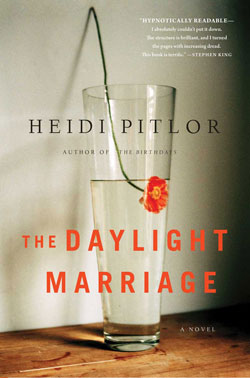The Daylight Marriage
by Heidi Pitlor
reviewed by Laura Albritton
In her second novel, Heidi Pitlor tackles the classic theme of a failed marriage by excavating one couple’s slide into dissatisfaction and unhappiness. A former editor at Houghton Mifflin and now editor of The Best American Short Stories, Pitlor is also the author of a previous book, The Birthdays. In her latest work, The Daylight Marriage, the writer delivers a piercing portrait of two people whose differences were never going to be reconciled.
The Daylight Marriage begins with Lovell Hall’s point of view, as he and his wife, Hannah, argue fiercely while undressing for bed. Hannah, “with a dancer’s long neck and pale gray-green eyes and deep dimples,” has forgotten to pay their electric bill for the third time that year. Pitlor depicts their foundering union through sharp dialogue, as Lovell, a climate scientist, asks, “Why is everything so hard for you? I mean in terms of work and daily life and even us.” For her part, Hannah despairs of her unfulfilling part-time job working in a flower shop. “I’m almost forty,” she says. “I can’t exactly dream up some new life and, poof, just start over,” adding dramatically, “my whole life feels like an epilogue.”
At this Lovell retorts, “Who really says that? Some woman in an Ibsen play?” Pitlor’s reference to A Doll’s House reminds us of an era when financially comfortable women were literally trapped by society’s laws, but the passage also suggests a more contemporary phenomenon: the well-educated, “underemployed” woman who finds that in prioritizing her children, spouse, and house, her own aspirations remain unrealized. Just as Nora leaves home at the end of A Doll’s House, Hannah also runs away after their argument escalates.
Hannah’s disappearance occurs at the beginning of The Daylight Marriage, however, and when she doesn’t return, the police get involved. Now Pitlor’s narrative structure becomes clear: the book shifts between Lovell and Hannah’s points of view, between the present moment when the husband and their two children cope with her absence, and flashbacks, as the reader discovers what Hannah actually did. The Daylight Marriage may not be a mystery novel in the classical sense, but the incremental revelations create a similar momentum.
When the narrative switches to Hannah’s perspective, we learn that she is not merely a victim but a complicated adult with her own limitations. One moment she angrily reflects that Lovell “was stunted, too male, too myopic to comprehend that the piddling things were in fact those bills and cars and recycling,” while the next she admits to herself, “There was nothing new about women despising their drudgery. There was nothing new about women wanting more.” It’s fascinating to watch Pitlor test and prod female archetypes as she portrays Hannah’s frustration and depression.
With her sudden freedom, Hannah muses, “If she could do anything she wanted today, anything at all? She didn’t know. She had no idea.” The novel gradually achieves a full portrait of a formerly ambitious woman who, having largely relinquished that ambition to concentrate on family, has become complicit in the process, like a prisoner helping to construct prison walls. She can recall a catalog of Lovell’s mistakes, and sees plainly how he failed her, but has no concept of how to move beyond this dismal history. Hannah’s actions as she abandons home don’t amount to a glorious escape, but rather, a confused attempt to locate some past excitement, a younger version of herself.
Husband Lovell must confront his daughter Janine’s and son Ethan’s trauma as the police interview them, neighbors hold a vigil, and little hints of Hannah’s fate start to surface. He deconstructs their marriage and the reasons for its implosion: “Over time, her unending complaints became like sandpaper that scratched a big raw part of him.” Meanwhile, the reader’s inevitable hope that Hannah will emerge unscathed dwindles as Pitlor reveals more of her character’s reckless decisions. The result is a shrewdly observed, unsettling work, one that takes a revenge fantasy that has probably occurred to more than one housewife, “What if I just ran away?” and brings it to an unexpected and tragic conclusion.
In Ibsen’s A Doll’s House, which premiered in 1879, we understand that Nora’s departure will likely lead to tragedy. It may well be that the fate that befalls Hannah has an irreproachable, internal logic, given her temperament and life history. Yet as I read the novel’s final pages, I couldn’t help but wonder whether this twenty-first century protagonist had been unduly punished for her fits of nostalgia, her quixotic rebellion, and her romanticism.
Published on April 23, 2015

